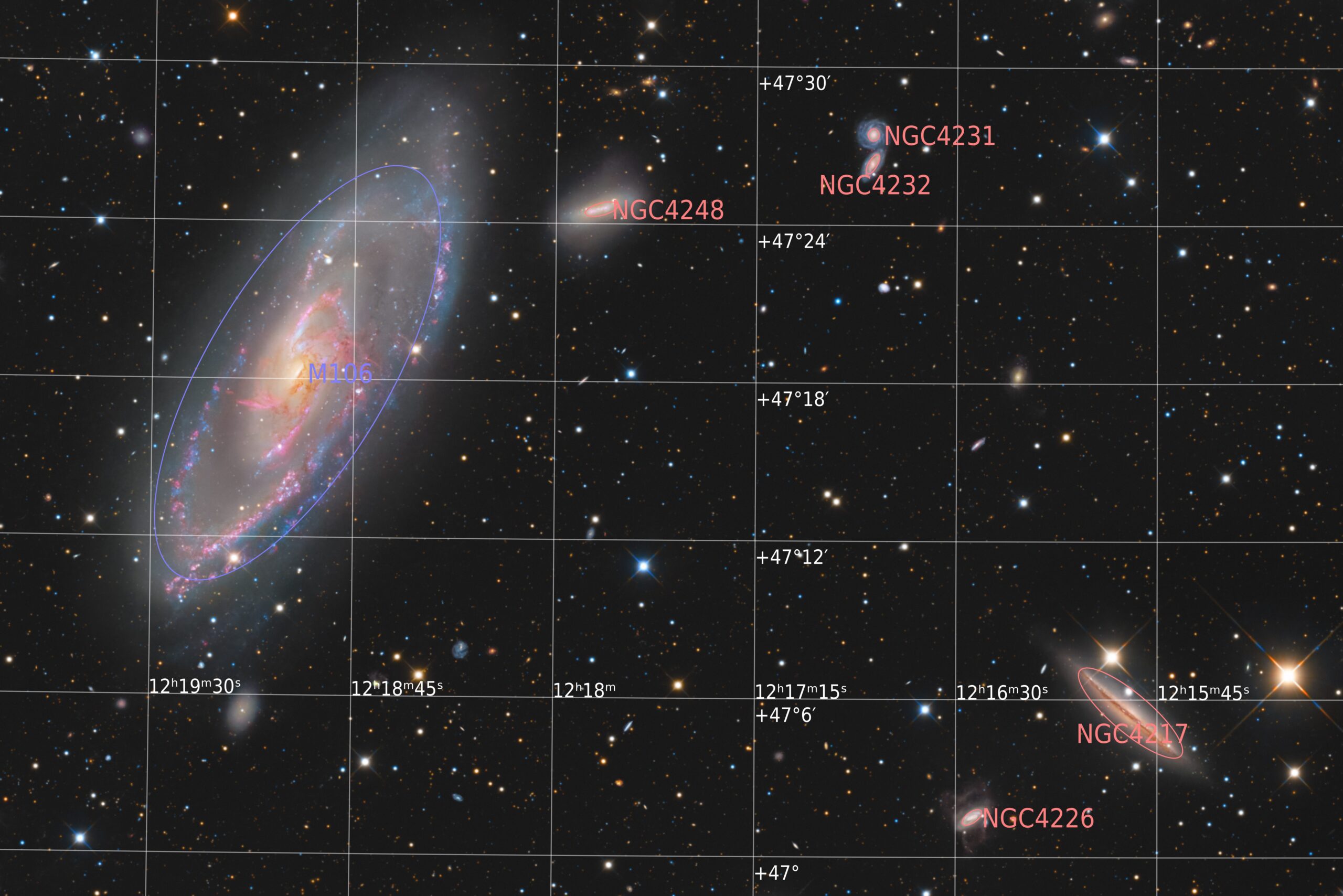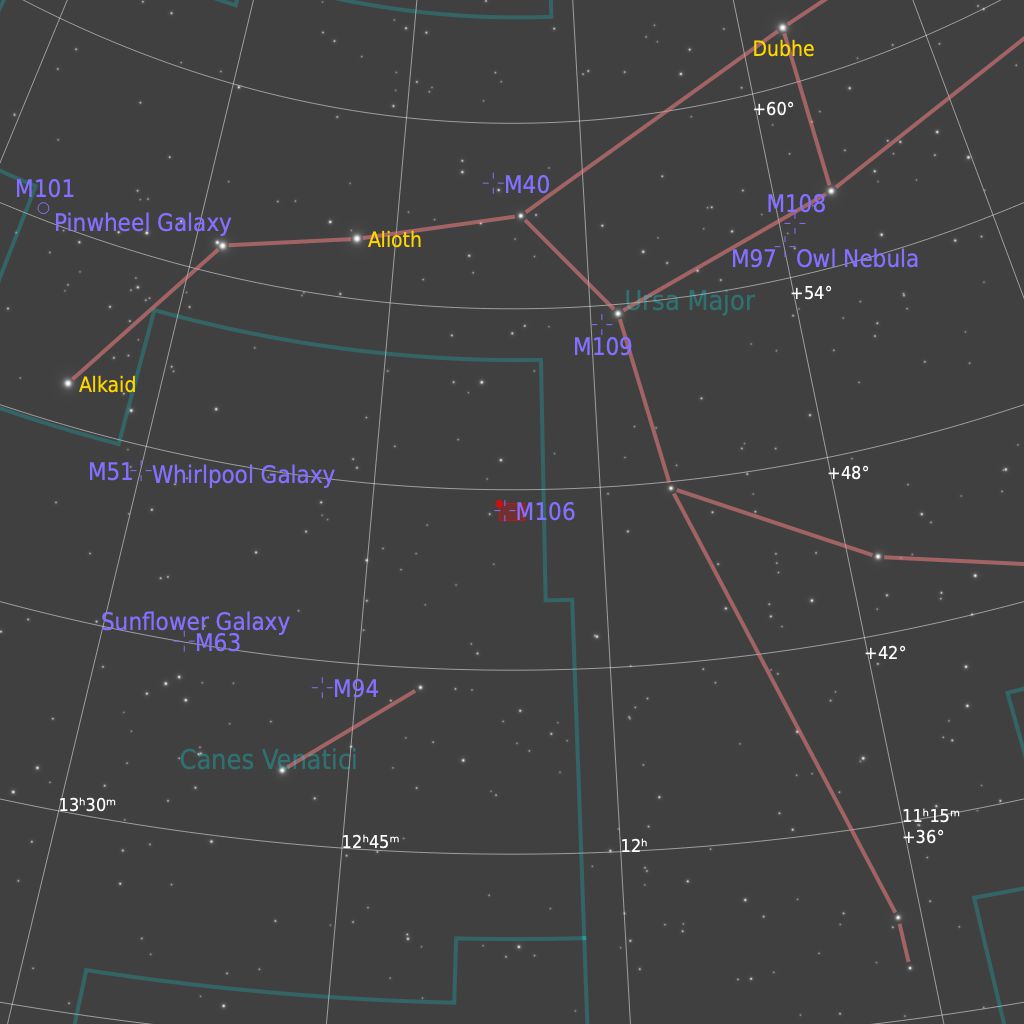Messier 106 (NGC 4258): A Galactic Powerhouse
I’m excited to share our latest Deep Sky Collective (DSC) project focusing on Messier 106 (M106), an intermediate spiral galaxy in Canes Venatici, roughly 23 million light-years away and spanning about 135,000 ly across. M106 is home to an active supermassive black hole that drives powerful jets—often called “anomalous arms” or outflows—making it an ideal subject for deep, multi-wavelength study.
Capturing M106
We began imaging M106 in February and gathered data for three months, followed by two months of intensive pre- and post-processing. Altogether, 18 team members participated, contributing a record-breaking 566 hours 02 minutes of integration, including:
•226 h 06 m of Hydrogen-alpha (Ha)
•80 h 30 m of Oxygen III ([O III])
•141 h 24 m of Luminance
Our main goal was to highlight both the galaxy’s structure and the faint outflows using Ha and [O III], backed by robust Luminance data for overall depth and clarity.
The Outflows and Anomalous Arms
M106’s supermassive black hole powers energetic jets that give rise to these outflows. They emit strongly in Ha, and less commonly in [O III], making it particularly exciting to gather more than 80 hours of [O III] data. Once we performed our usual continuum subtraction (to isolate the emission lines), it became clear that M106’s east side especially showed notable [O III] filaments.
It’s worth noting that M106’s jets and outflows extend beyond just optical wavelengths—radio, X-ray, and infrared observations all reveal different facets of this ongoing galactic drama. Our team even combined professional data from Chandra (X-ray), the VLT (radio), and Spitzer (IR) with our optical imagery. If you’d like to see that multiwavelength composite, you can find it here:
https://deepskycollective.com/m106/multiwave
Other Galactic Gems
Smaller Galaxies with Outflows
Our final image captures several smaller active galaxies that also have striking outflows—some even larger than the galaxies themselves. Over 250 hours of broadband imaging ensured these features came through clearly.
Background Galaxies
One of the joys of such a deep dataset is discovering countless distant galaxies scattered through the field. By zooming in, you’ll see red smudges or faint streaks—each one a galaxy many millions or even hundreds of millions of light-years away. Notable favorites include:
•NGC 4217, a large galaxy to the right of M106.
•NGC 4231 & NGC 4232, a merging pair 350+ million light-years away—likely the clearest amateur image yet of these interacting galaxies.
Extreme Depth
We calculated our limiting magnitude to be around m 23.3 in the raw stack and m 24.0 after advanced noise reduction—only about one magnitude shy of professional observatory standards. Special thanks to Steve Mandel for identifying the field’s most distant objects, one of which is a mind-boggling 11.7 billion light-years away!
My Role in the Project
As the final editor, I (Steeve Body) was responsible for combining and processing the Ha, [O III], and broadband data into one cohesive image. Balancing faint emission lines, highlighting subtle structures in the outflows, and preserving natural galaxy detail made for a challenging but rewarding experience.
Meet the Team
- Tim Schaeffer – Coordinator
- Steeve Body (Processing)
- Adrien Keijzer – Stacker•Carl Björk – Assistant Stacker
- Ryan Wierckx
- Logan Carpenter
- Nicolas Puig
- Paul Kent
- Mike Hamende
- Spencer Collins
- Steve Mandel
- Brian Meyers
- Laurent André
- Oliver Carter
- Nicola Beltraminelli
- Bogdan Borz
- Julian Shapiro
- Antoine and Dalia Grelin – www.galactic-hunter.com
- BTB Astroteam Brentenriegel – Franz Gruber
Special Thanks
Adrien for meticulously stacking over 4,000 files—a demanding process that took weeks.
Carl for assisting with the stacking process.
Paul (and Tim) for providing excellent Bortle 2/3 data.
Laurent for sharing high-FL imagery to enhance core details.
Steve Mandel for analyzing redshifts and distances, uncovering those extraordinary far-flung objects.
https://deepskycollective.com/gallery
Thank you for joining us on this deep exploration of M106. We hope you enjoy the image as much as we enjoyed creating it! Clear skies!


